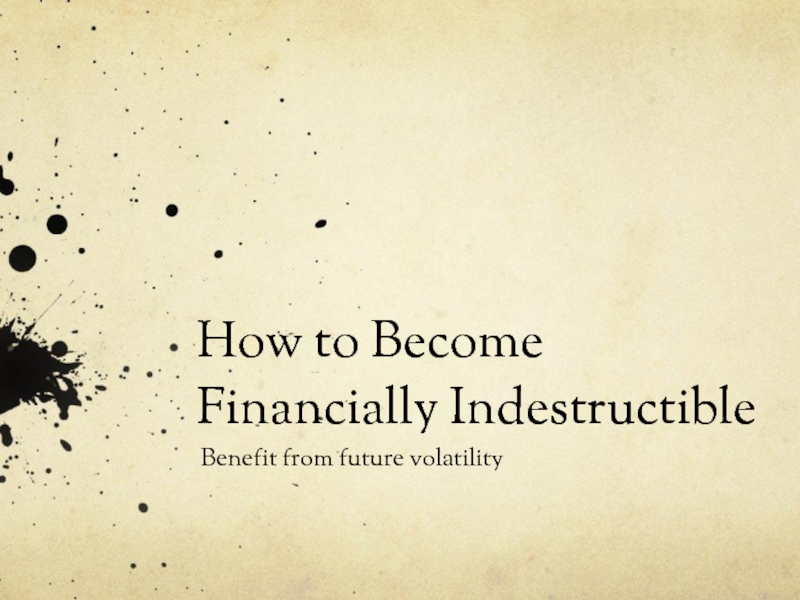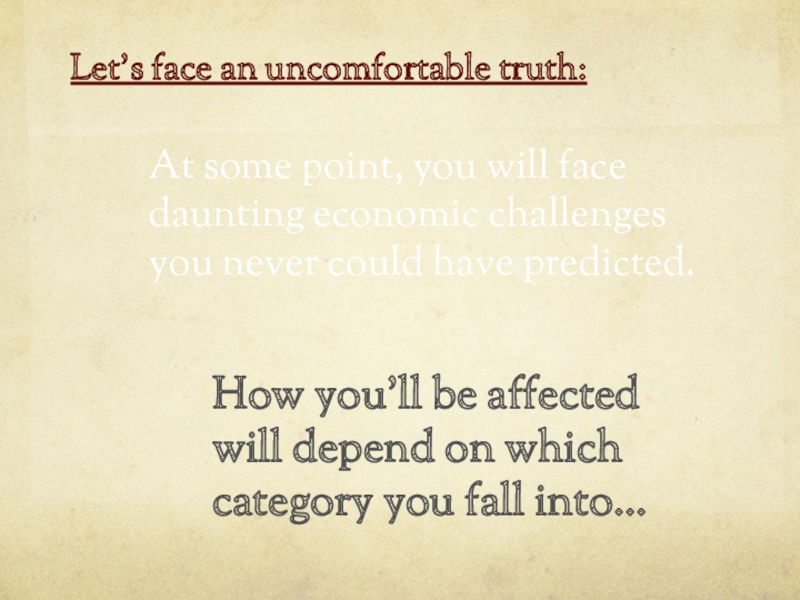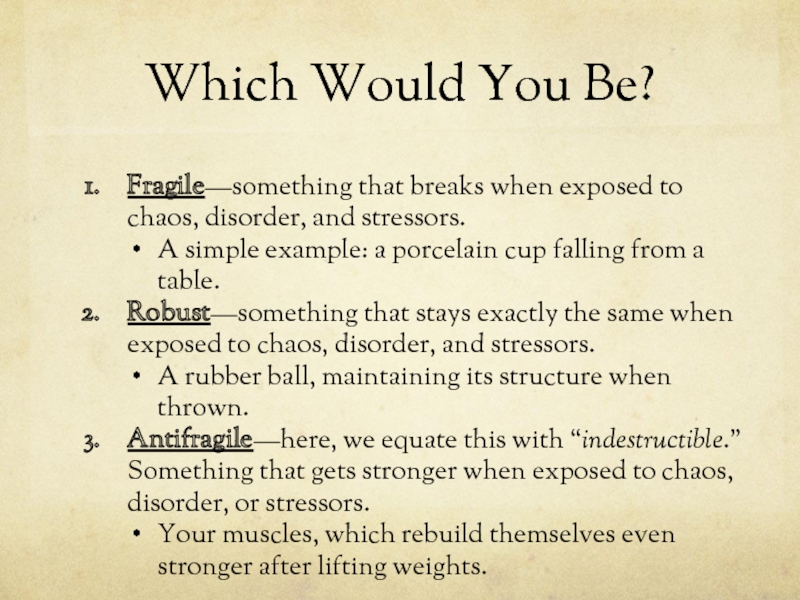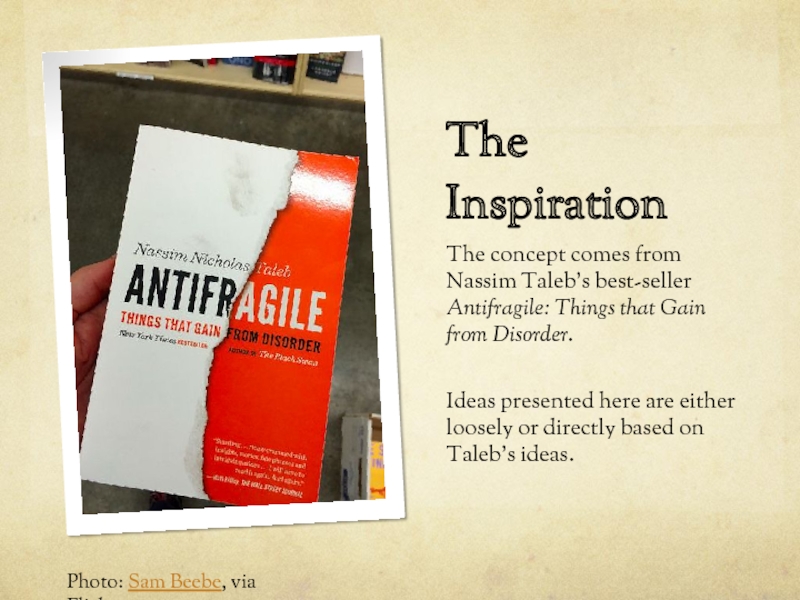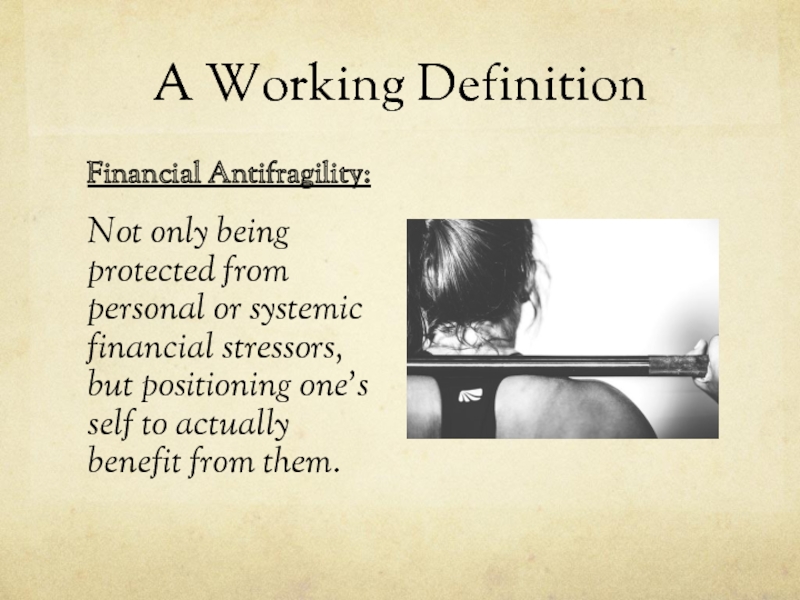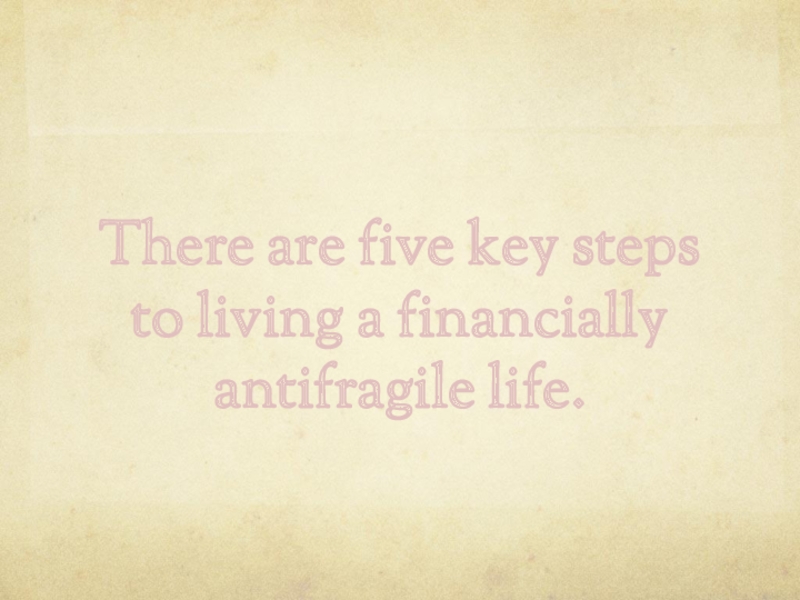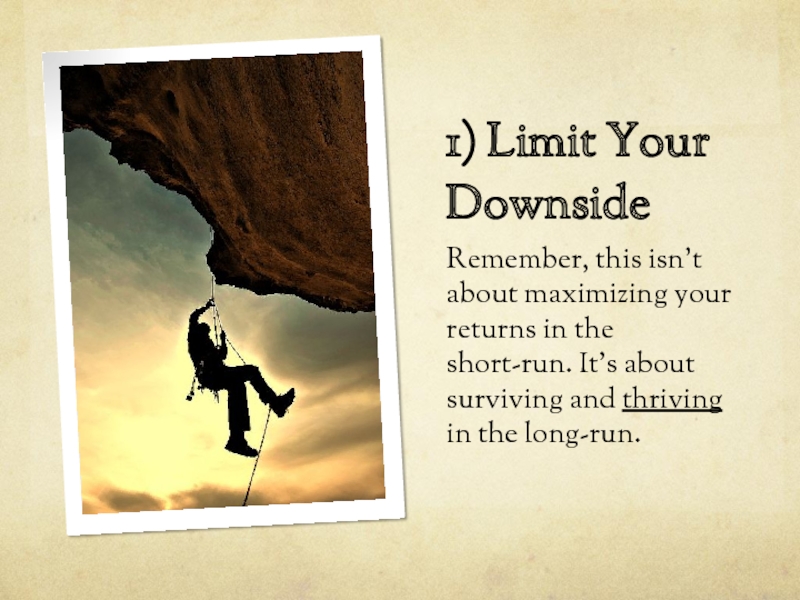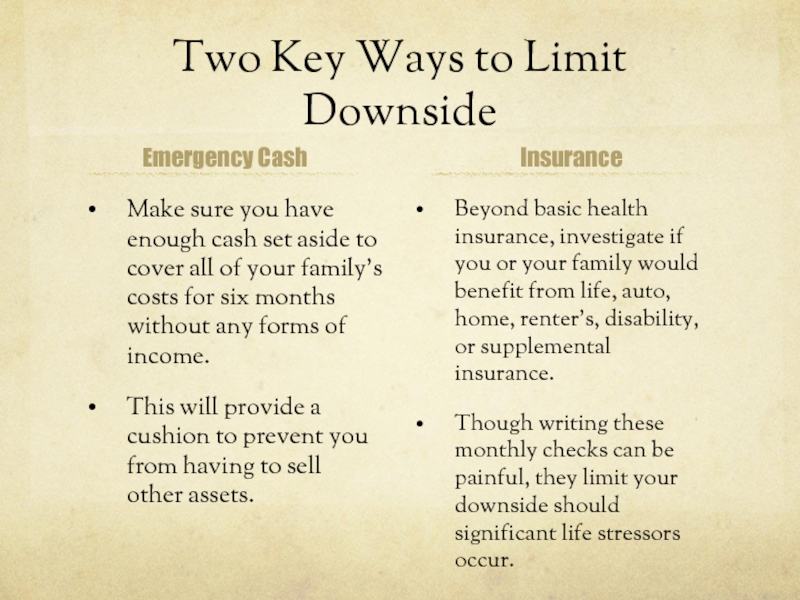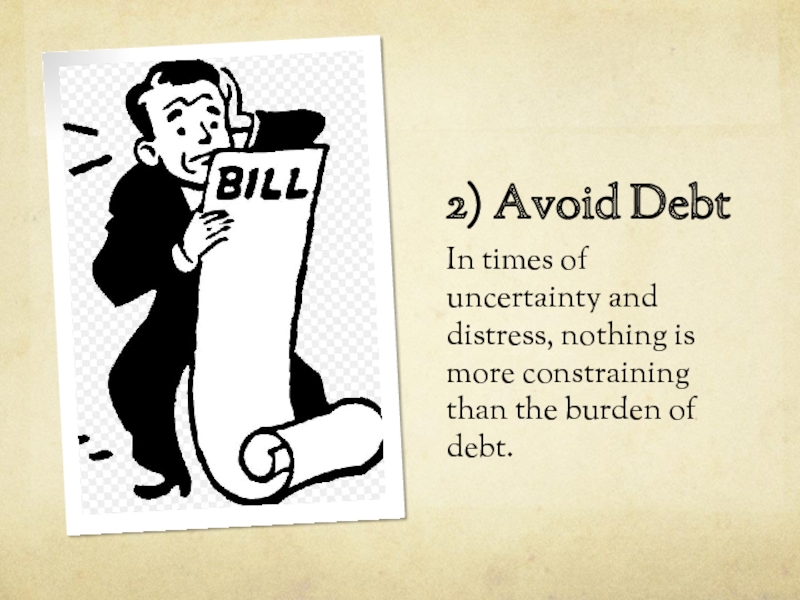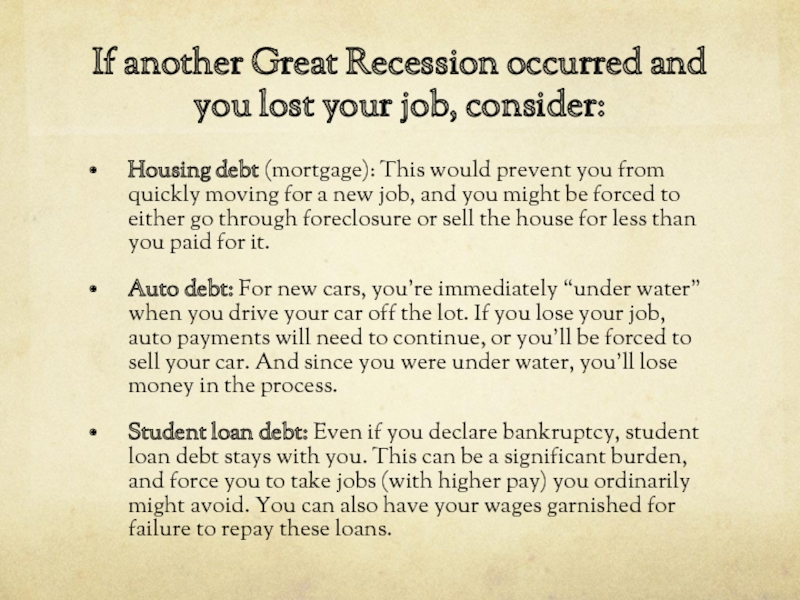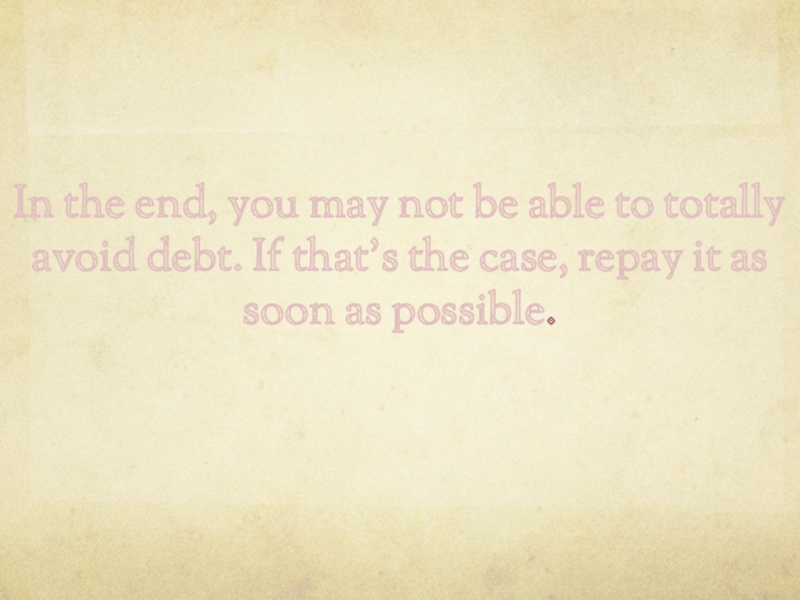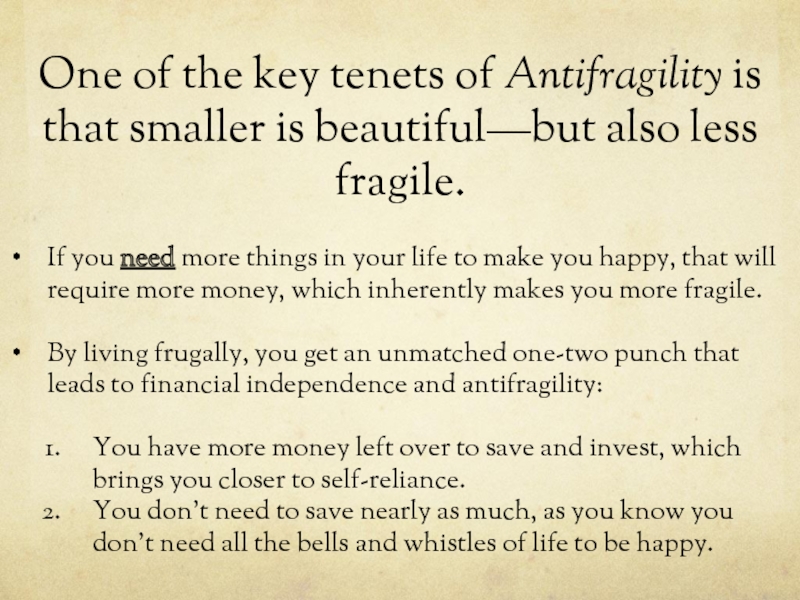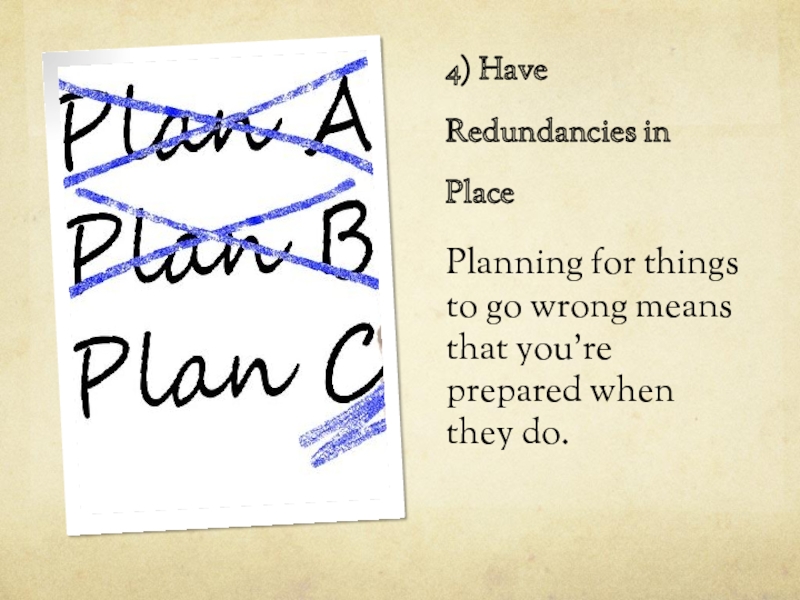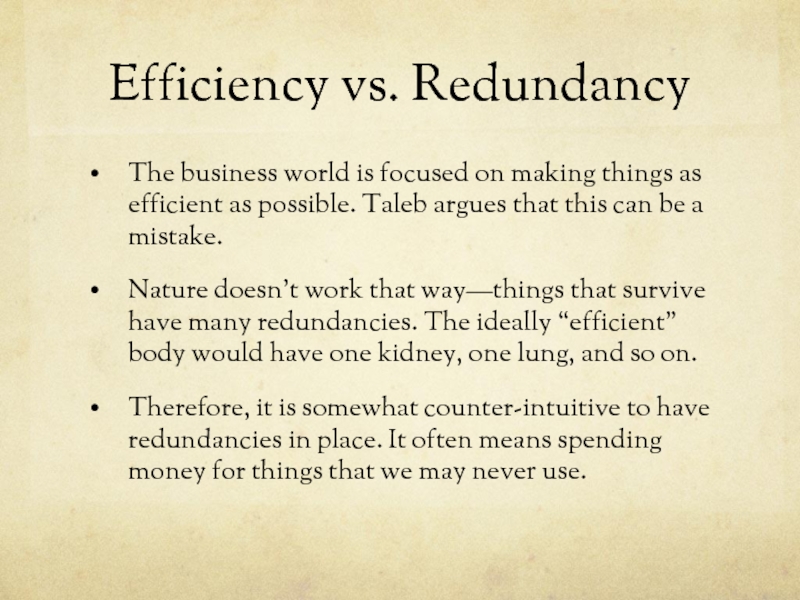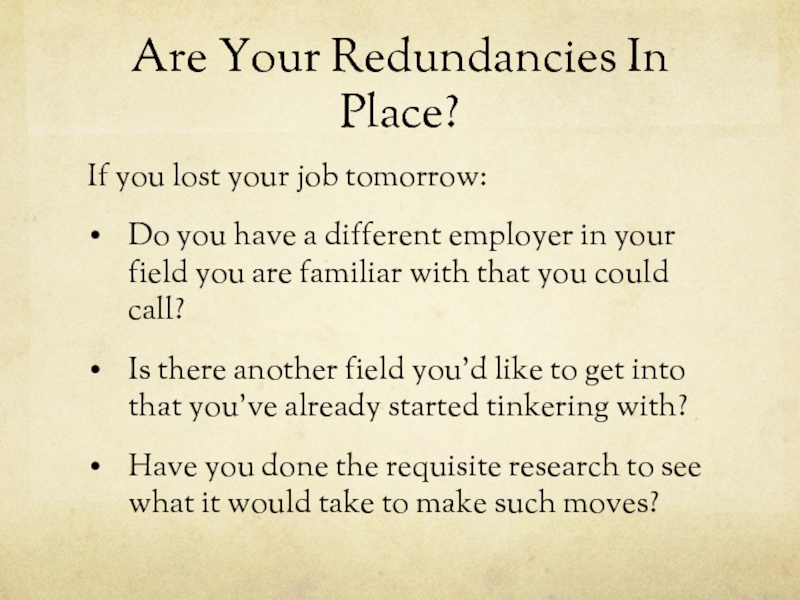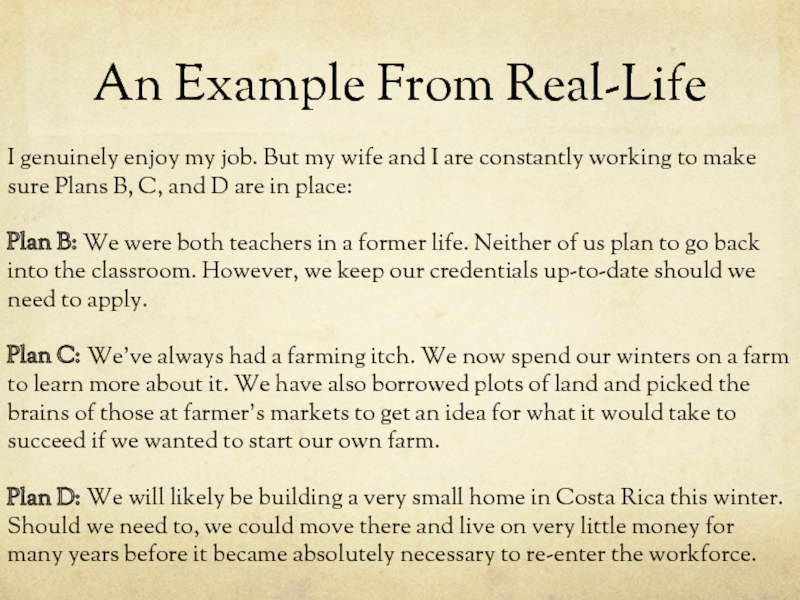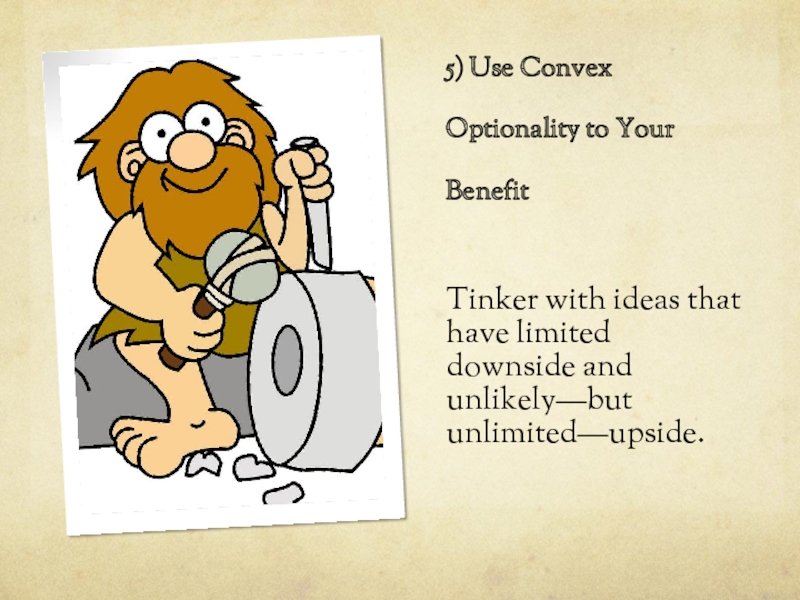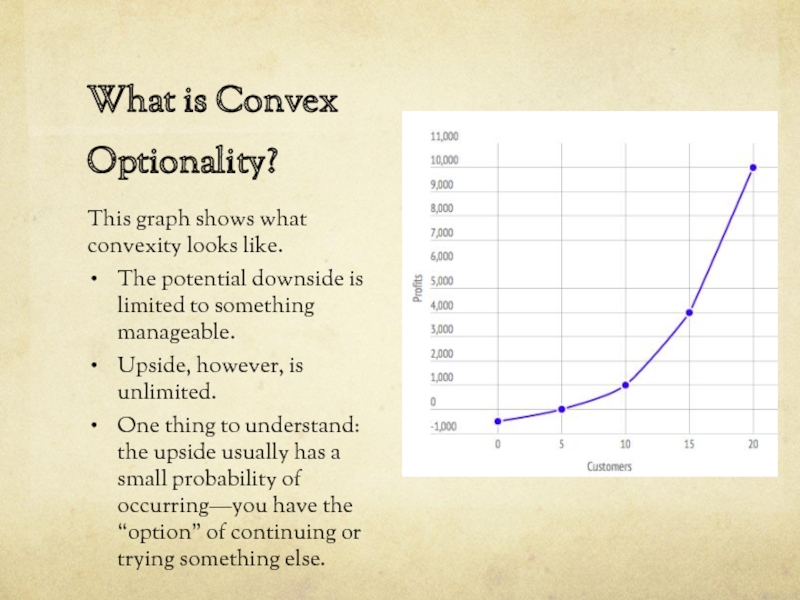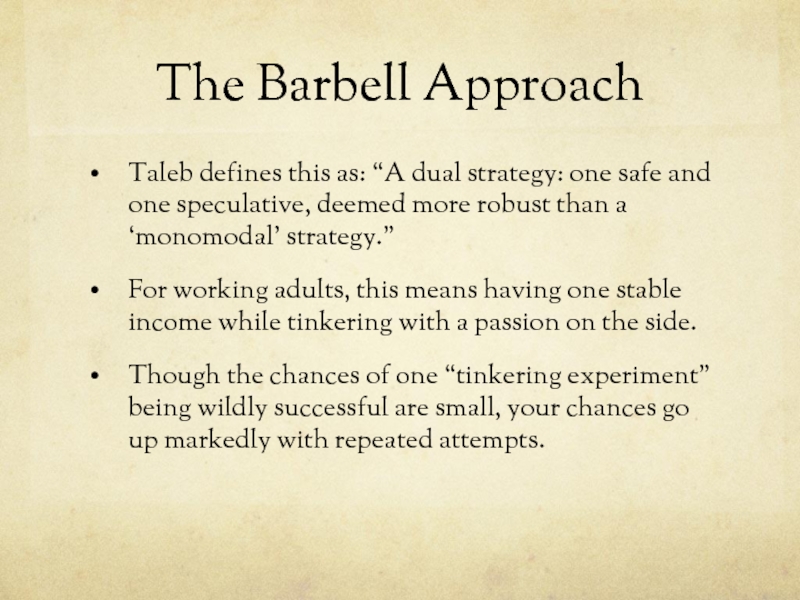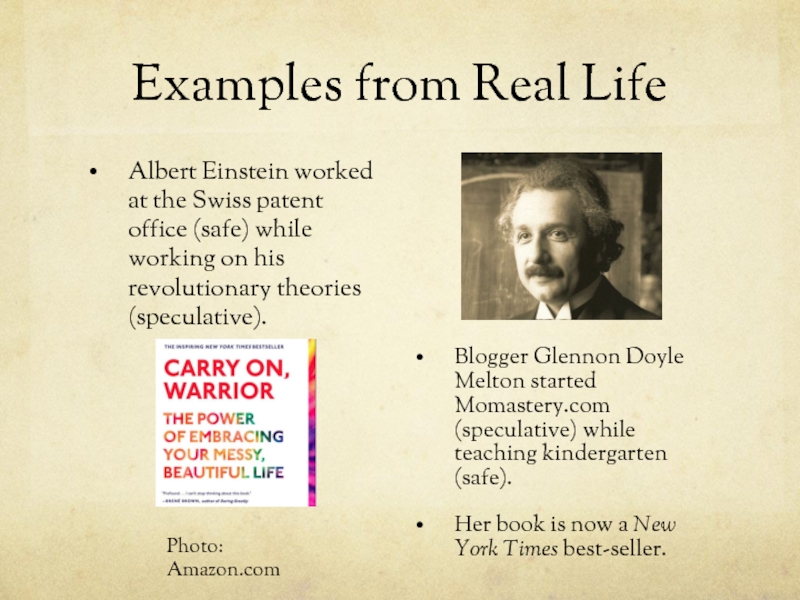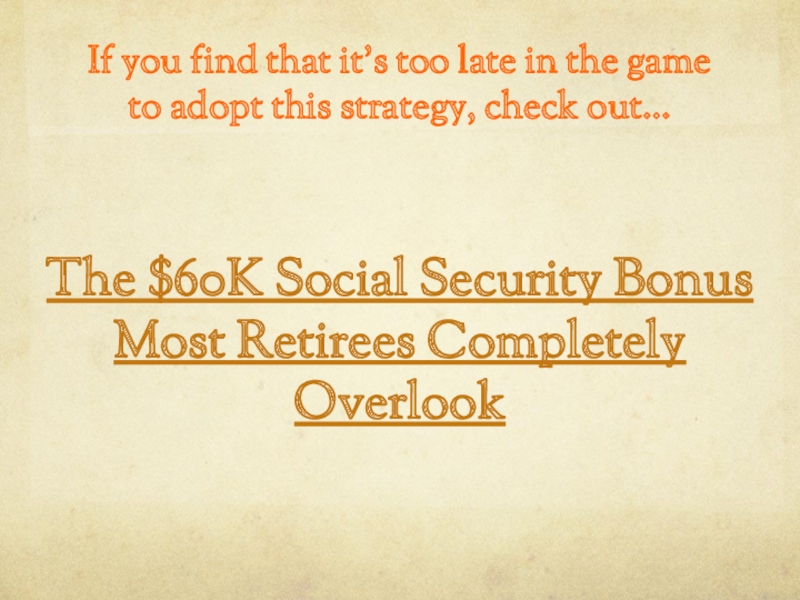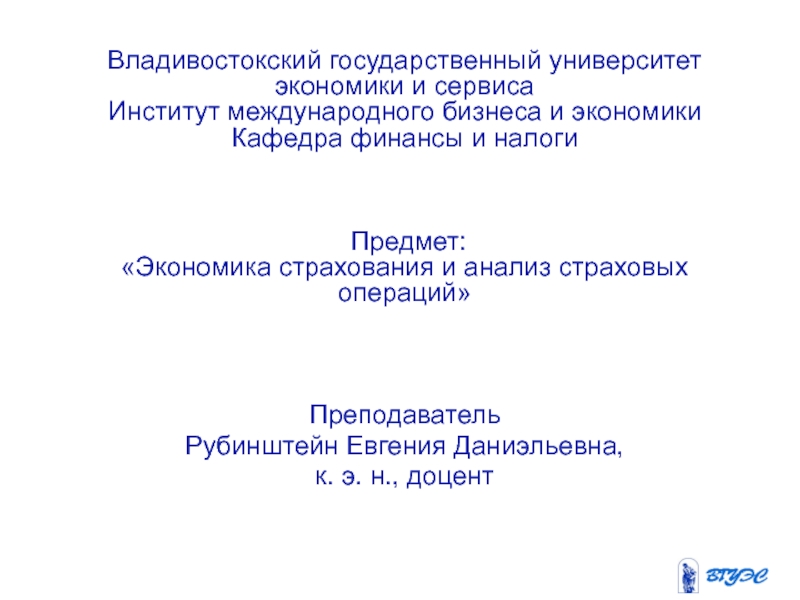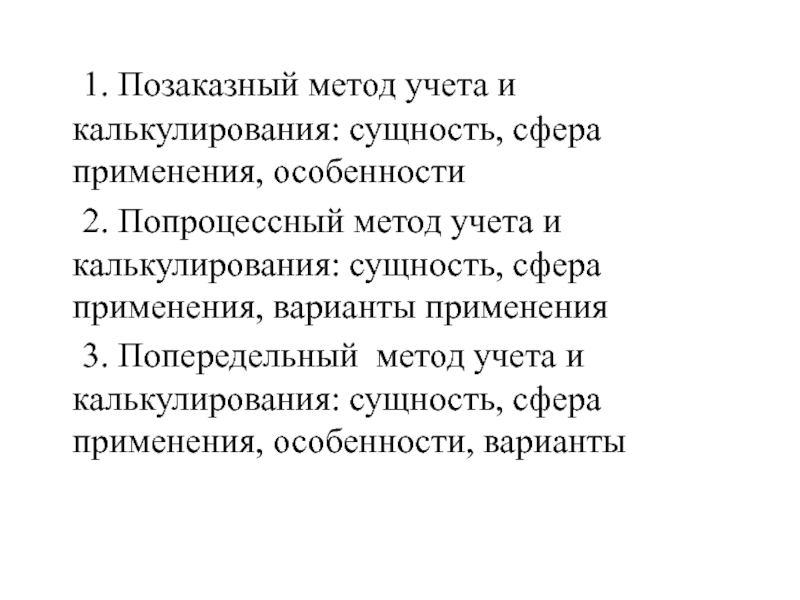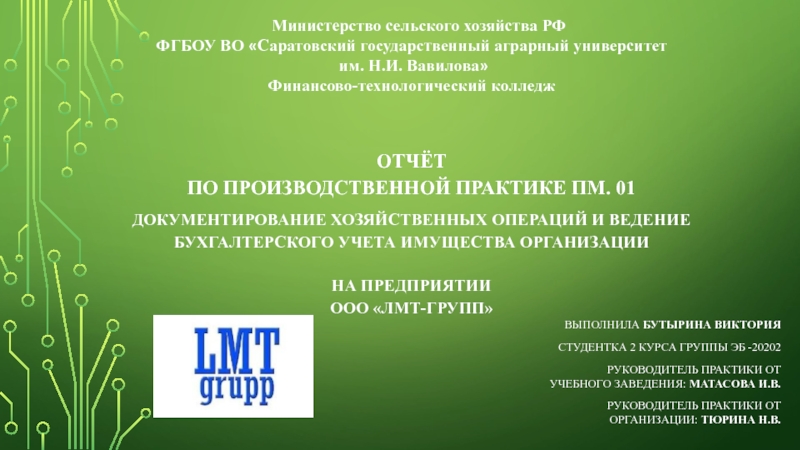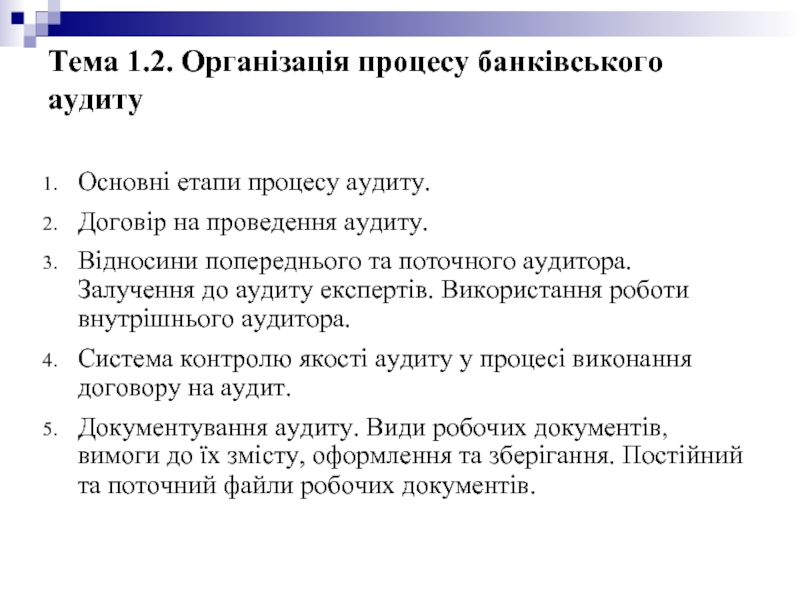- Главная
- Разное
- Дизайн
- Бизнес и предпринимательство
- Аналитика
- Образование
- Развлечения
- Красота и здоровье
- Финансы
- Государство
- Путешествия
- Спорт
- Недвижимость
- Армия
- Графика
- Культурология
- Еда и кулинария
- Лингвистика
- Английский язык
- Астрономия
- Алгебра
- Биология
- География
- Детские презентации
- Информатика
- История
- Литература
- Маркетинг
- Математика
- Медицина
- Менеджмент
- Музыка
- МХК
- Немецкий язык
- ОБЖ
- Обществознание
- Окружающий мир
- Педагогика
- Русский язык
- Технология
- Физика
- Философия
- Химия
- Шаблоны, картинки для презентаций
- Экология
- Экономика
- Юриспруденция
How to Become Financially Indestructible презентация
Содержание
- 1. How to Become Financially Indestructible
- 2. Let’s face an uncomfortable truth: At some
- 3. Which Would You Be? Fragile—something that breaks
- 4. The Inspiration The concept comes from Nassim
- 5. A Working Definition Financial Antifragility: Not only
- 6. There are five key steps to living a financially antifragile life.
- 7. 1) Limit Your Downside Remember, this isn’t
- 8. Two Key Ways to Limit Downside Emergency
- 9. 2) Avoid Debt In times of uncertainty
- 10. If another Great Recession occurred and you
- 11. In the end, you may not be
- 12. 3) Live Frugally The less you need to be happy, the freer you are!
- 13. One of the key tenets of Antifragility
- 14. 4) Have Redundancies in Place Planning for
- 15. Efficiency vs. Redundancy The business world is
- 16. Are Your Redundancies In Place? If you
- 17. An Example From Real-Life I genuinely enjoy
- 18. 5) Use Convex Optionality to Your Benefit
- 19. What is Convex Optionality? This graph shows
- 20. The Barbell Approach Taleb defines this as:
- 21. Examples from Real Life Albert Einstein worked
- 22. A Quick Review Limit Your Downside Avoid Debt Live Frugally Have Redundancies Embrace Convex Optionality
- 23. If you find that it’s too late
Слайд 2Let’s face an uncomfortable truth:
At some point, you will face daunting
How you’ll be affected will depend on which category you fall into…
Слайд 3Which Would You Be?
Fragile—something that breaks when exposed to chaos, disorder,
A simple example: a porcelain cup falling from a table.
Robust—something that stays exactly the same when exposed to chaos, disorder, and stressors.
A rubber ball, maintaining its structure when thrown.
Antifragile—here, we equate this with “indestructible.” Something that gets stronger when exposed to chaos, disorder, or stressors.
Your muscles, which rebuild themselves even stronger after lifting weights.
Слайд 4The Inspiration
The concept comes from Nassim Taleb’s best-seller Antifragile: Things that
Ideas presented here are either loosely or directly based on Taleb’s ideas.
Photo: Sam Beebe, via Flickr
Слайд 5A Working Definition
Financial Antifragility:
Not only being protected from personal or systemic
Слайд 71) Limit Your Downside
Remember, this isn’t about maximizing your returns in
Слайд 8Two Key Ways to Limit Downside
Emergency Cash
Make sure you have enough
This will provide a cushion to prevent you from having to sell other assets.
Insurance
Beyond basic health insurance, investigate if you or your family would benefit from life, auto, home, renter’s, disability, or supplemental insurance.
Though writing these monthly checks can be painful, they limit your downside should significant life stressors occur.
Слайд 92) Avoid Debt
In times of uncertainty and distress, nothing is more
Слайд 10If another Great Recession occurred and you lost your job, consider:
Housing
Auto debt: For new cars, you’re immediately “under water” when you drive your car off the lot. If you lose your job, auto payments will need to continue, or you’ll be forced to sell your car. And since you were under water, you’ll lose money in the process.
Student loan debt: Even if you declare bankruptcy, student loan debt stays with you. This can be a significant burden, and force you to take jobs (with higher pay) you ordinarily might avoid. You can also have your wages garnished for failure to repay these loans.
Слайд 11In the end, you may not be able to totally avoid
Слайд 13One of the key tenets of Antifragility is that smaller is
If you need more things in your life to make you happy, that will require more money, which inherently makes you more fragile.
By living frugally, you get an unmatched one-two punch that leads to financial independence and antifragility:
You have more money left over to save and invest, which brings you closer to self-reliance.
You don’t need to save nearly as much, as you know you don’t need all the bells and whistles of life to be happy.
Слайд 144) Have Redundancies in Place
Planning for things to go wrong means
Слайд 15Efficiency vs. Redundancy
The business world is focused on making things as
Nature doesn’t work that way—things that survive have many redundancies. The ideally “efficient” body would have one kidney, one lung, and so on.
Therefore, it is somewhat counter-intuitive to have redundancies in place. It often means spending money for things that we may never use.
Слайд 16Are Your Redundancies In Place?
If you lost your job tomorrow:
Do you
Is there another field you’d like to get into that you’ve already started tinkering with?
Have you done the requisite research to see what it would take to make such moves?
Слайд 17An Example From Real-Life
I genuinely enjoy my job. But my wife
Plan B: We were both teachers in a former life. Neither of us plan to go back into the classroom. However, we keep our credentials up-to-date should we need to apply.
Plan C: We’ve always had a farming itch. We now spend our winters on a farm to learn more about it. We have also borrowed plots of land and picked the brains of those at farmer’s markets to get an idea for what it would take to succeed if we wanted to start our own farm.
Plan D: We will likely be building a very small home in Costa Rica this winter. Should we need to, we could move there and live on very little money for many years before it became absolutely necessary to re-enter the workforce.
Слайд 185) Use Convex Optionality to Your Benefit
Tinker with ideas that have
Слайд 19What is Convex Optionality?
This graph shows what convexity looks like.
The potential
Upside, however, is unlimited.
One thing to understand: the upside usually has a small probability of occurring—you have the “option” of continuing or trying something else.
Слайд 20The Barbell Approach
Taleb defines this as: “A dual strategy: one safe
For working adults, this means having one stable income while tinkering with a passion on the side.
Though the chances of one “tinkering experiment” being wildly successful are small, your chances go up markedly with repeated attempts.
Слайд 21Examples from Real Life
Albert Einstein worked at the Swiss patent office
Blogger Glennon Doyle Melton started Momastery.com (speculative) while teaching kindergarten (safe).
Her book is now a New York Times best-seller.
Photo: Amazon.com
Слайд 22A Quick Review
Limit Your Downside
Avoid Debt
Live Frugally
Have Redundancies
Embrace Convex Optionality
Слайд 23If you find that it’s too late in the game to
The $60K Social Security Bonus Most Retirees Completely Overlook
